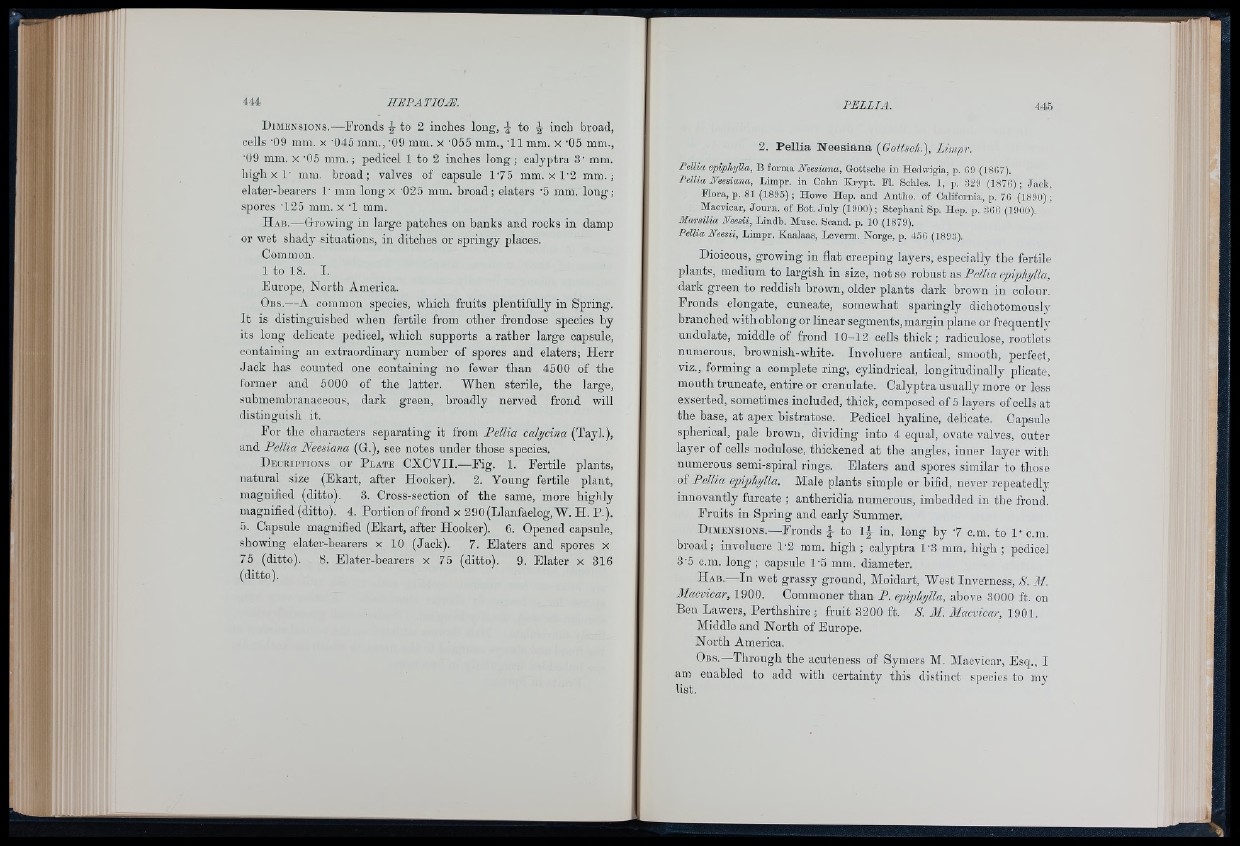
Dim ensions.— F ro n d s ^ to 2 inches long, g to J inch broad,
cells '0 9 mill, x '0 4 5 m m . , '0 9 m m . x '0 5 5 m m . , T l m r a . x "05 m m . ,
’0 9 m m . X '05 m m . ; pedicel 1 to 2 inches lo n g ; c a ly p tra 3' mm .
h i g h x l ' nnn. b ro a d ; valves o f capsule 1 7 5 m m . x 1 '2 m m . ;
elater-bearers 1' m m long x '0 2 5 m m . b ro ad ; elaters A m m . lo n g ;
spores T 2 5 m m . x T m m .
H.ab.—Growing in large patches on banks and rooks in damp
or wet shady situations, in ditches or springy places.
Common.
1 to 18. I.
Europe, North America.
O b s .— A common species, which fruits plentifully in Spring.
It is distinguished when fertile from other frondose species hy
its long delicate pedicel, which supports a rather large capsule,
containing an extraordinary number of spores and elaters; Herr
Jack has counted one containing no fewer than 4500 of the
I'ormer and 5000 of the latter. "When sterile, the large,
submembranaceous, dark green, broadly nerved frond will
distinguish it.
For the characters separating it from Pellia calycina (Tayl.),
and Pellia Neesiana (G.), see notes under those species.
D ecriptions of P late CXCVII.—Pig. 1. Fertile plants,
natural size (Ekart, after Hooker). 2. Young fertile plant,
magnified (ditto). 3. Cross-section of the same, more higlily
magnified (ditto). 4. Portion of frond x 290 (Llanfaelog, W. H. P.).
5. Capsule magnified (Ekart, after Hooker). 6. Opened capsule,
showing elater-bearers x 10 (Jack). 7. Elaters and spores x
75 (ditto). 8. Elater-bearers x 75 (ditto). 9. Elater x 316
(ditto).
2. Pellia Neesiana {GoUscL), Limpr.
Pelha epiphylla, B forma Neesiana, Gottscbe in Hedwigia, p. 69 ( 1867),
Pellia Neesiana, Limpr. in Cohn Krypt. F l. Schles. 1, p. 329 (18 76); Jack,
Flora, p. 81 (18 9 5 ); Howe Hep. and Antho, of California, p. 76 (1890);
Macvicar, Journ. of Bot. Ju ly (19 00 ); Stephani Sp. Hep. p. 366 (1900).
Marsilia Neesii, Lindb. Muse. Scand. p. 10 (1879).
Pellia Neesii, Limpr. Kaalaas, Leverm. Norge, p. 456 (1893).
Dioicous, growing in flat creeping layers, especially the fertile
plants, medium to largish in size, not so robust as Pellia ejjiphylla.
dark green to reddish brown, older plants dark brown in colour.
Fronds elongate, cuneate, somewhat sparingly dichotomously
branched with oblong or linear segments, margin plane or frequently
undulate, middle of frond 10—12 cells th ic k ; radiculose, rootlets
numerous, brownish-white. Involucre antical, smooth, perfect,
viz., forming a complete ring, cylindrical, longitudinally plicate,
mouth truncate, entire or crenulate. Calyptra usually more or less
exserted, sometimes included, thick, composed of 5 layers of cells at
the base, at apex bistratose. Pedicel hyaline, delicate. Capsule
spherical, pale brown, dividing into 4 equal, ovate valves, outer
layer of cells nodulose, thickened at the angles, inner layer with
numerous semi-spiral rings. Elaters and spores similar to those
ot Pellia epijjhylla. Male plants simple or bifid, never repeatedly
innovantly furcate ; antheridia numerous, imbedded in tlie frond.
Fruits in Spring and early Summer.
D imensions.—Fronds ^ to I j in. long hy '7 c.m. to 1’ c.ni.
broad; involucre 1'2 mni. h ig h ; calyptra 1'3 mm. h igh; pedicel
3 A c.m. long ; capsule lA mm. diameter.
H a b .— In wet grassy ground, Moidart, West Inverness, S. II.
Macvicar, 1900. Commoner than P. epiphylla, above 3000 ft. on
Ben Lawers, Perthshire ; fruit 3200 ft. S. M. Macvicar, 1901,
Middle and North of Europe.
North America.
O b s .—Through the acuteness of Symers M. Macvicar, Esq., I
am enabled to add with certainty this distinct species to my
list.